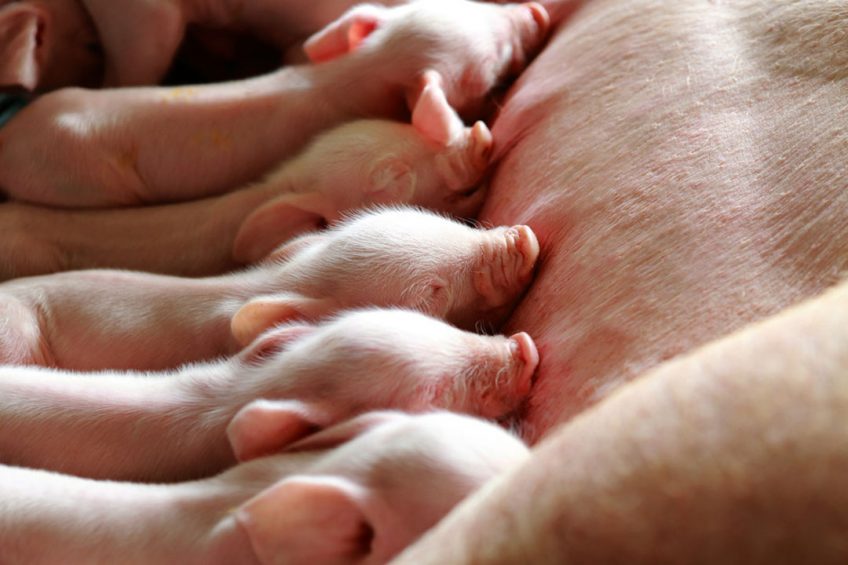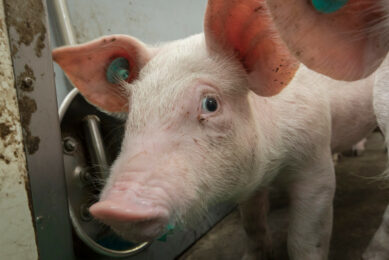Better litter uniformity via sow nutrition

The milk production of the sow is a limiting factor when it comes to piglet growth prior to weaning. Much has been done to support the piglet to alleviate the negative effects of a lack of milk supply by the sow. Of equal importance is the question of what can be done for the sow to help satisfy the requirements of her litter?
It is commonly known that milk production highly depends on the nutritional status of the sow. Nevertheless, genetic progress over the last decades makes it almost impossible for the sow to produce enough milk for the perpetually increasing litter sizes. The negative effects of a shortage of sows’ milk on piglets can be seen first at weaning. Even at similar birth weights the percentage of lighter weaners under 7kg after a suckling time of four weeks is markedly higher when there is a shortage of milk supply during suckling. This decreased weight leads to a more pronounced growth check after weaning, with all its negative consequences. Due to the many stress factors pigs have to deal with at weaning, lighter weaned pigs are more likely to eat less or not at all in the first days after weaning. This leads to detrimental effects that influence performance over the life of the pig. Starting with an increased likelihood of developing diarrhoea, but also a higher susceptibility to other diseases which can be found in pig production due to the negative effects of not only the stress around weaning but also the lack of feed intake on gut health. Later in life a reduced weaning weight can have negative effects; several studies have shown, that a reduction in feed intake the first week to 10 days after weaning can increase the days to slaughter weight in severe cases by up to 10 days.
How to ease the situation
The traditional way of trying to avoid the negative effects of the shortage of milk from the sow is the usage of creep feed. This is an effective way to avoid the negative effects of a lack of milk and to allow the piglets to become familiar with solid feed before weaning. However, studies have shown that the piglets that consume the most milk also have a higher creep feed intake and not, as anticipated, the piglets that are undernourished due to the shortage of milk from the sow. Another way to ease the situation is the use of milk replacers or more novel, nutritionally enriched powders which are dissolved in drinking water. However, this method is for some producers sometimes not practical due to the extra amount of work load on the farm staff in the already busy environment of the farrowing rooms. Another option is trying to combat the problems caused by a milk shortage right after weaning. Several studies have shown that feeding high density, highly digestible diets to weaners results in high growth rates with less digestive upsets provided adequate feed intake is achieved. However, this can be an expensive way to combat the problem and results in negative effects on the producers’ financial outcome.
Can something be done for the sow?
Due to the limitations of the methods targeted at the piglet to alleviate the problems of a milk shortage in sows the question arose of what could be done for the sow, which positively affects the piglet around weaning. To investigate this a trial was conducted using 300 highly-prolific sows. They were assigned to 2 treatments, (T1) a control diet and (T2) the control diet with 500 g of Krave, an appetite stimulant, resulting in 100 sows per treatment. Cross-fostering was applied within the first 48 hours after farrowing to standardise the litter size at 15 piglets. Measured parameters are shown in Table 1.
Milk production was significantly improved in the treatment in which the appetite stimulant was fed. Surprisingly, body weight loss did not differ in between the treatments as you would expect a higher body weight loss in sows with higher milk production due to mobilising energy reserves. The higher milk production would also be expected to lead to differences in back fat thickness at weaning and an increased weaning-to-oestrus interval, which was also not the case in this study, even though it is known that highly prolific sows utilise feed much better. The fact, that no differences in body weight loss or back fat thickness were found might also have been derived from the significantly higher average daily feed intake in the sows receiving the appetite stimulant.
Figure 1 – Piglet weight distribution.
Piglet performance showed a more even weaning weight distribution in the groups receiving the appetite stimulant as shown in Figure 1. The effect of the treatment on weaning weight variation within litters is shown in Figure 2 and demonstrates the positive effects of the appetite stimulant fed to the sow.
Improved piglet uniformity
Adding Krave to the diet of lactating sows improved piglet uniformity at weaning, which can result in better pig health around weaning and less days to reach market weight. The application method is simple compared to the application of other products targeting the same problem. There may also be a possibility that the appetite stimulant in combination with one of the other strategies may produce even better results. In conclusion, it can be said, that the usage of Krave represents a possibility to improve the economic benefits of pig production in a simple way.
Author: Angela Riemensperger and Simon Eskinazi, Adisseo











